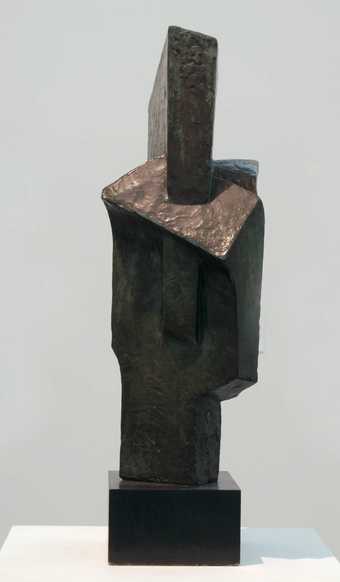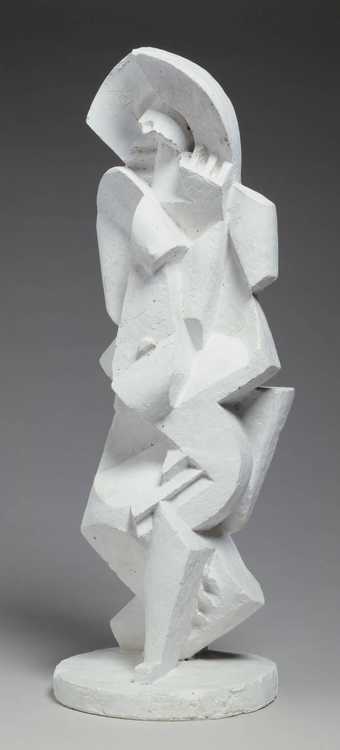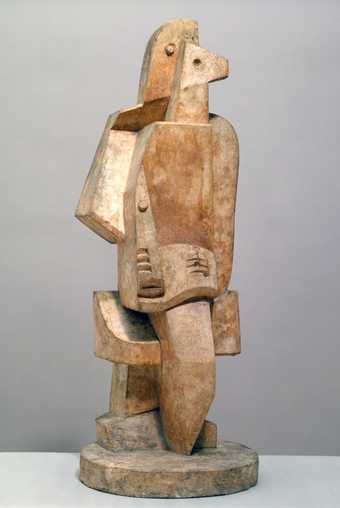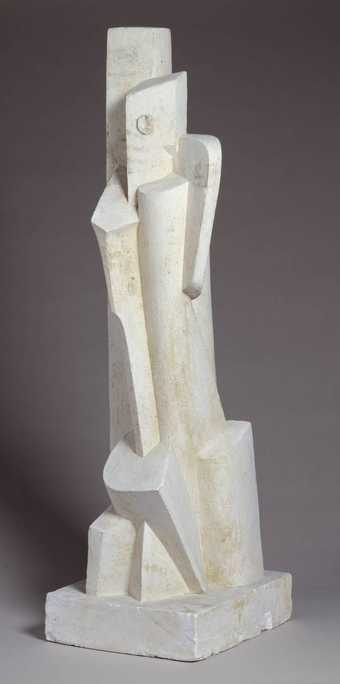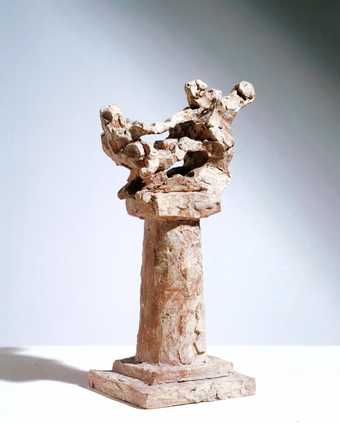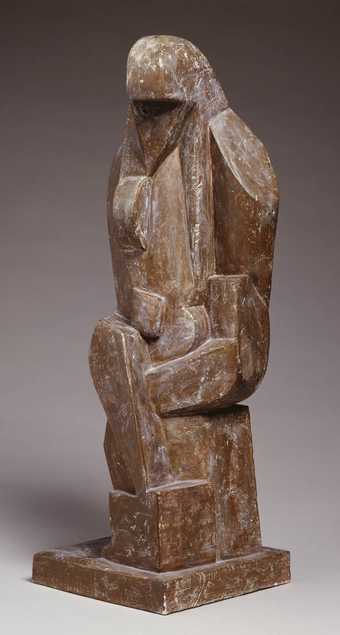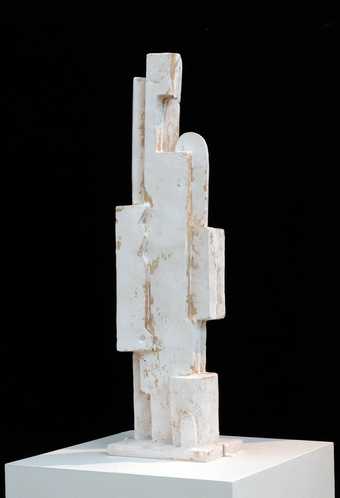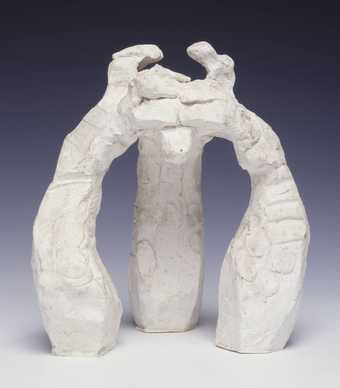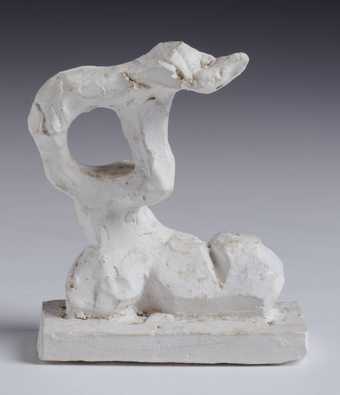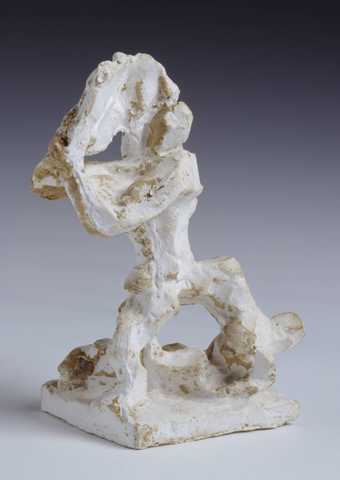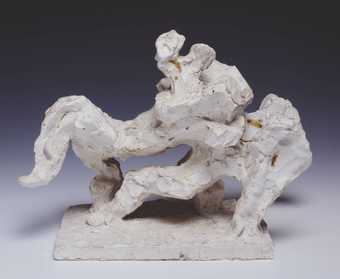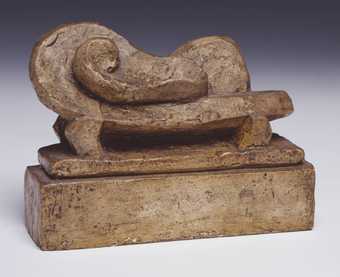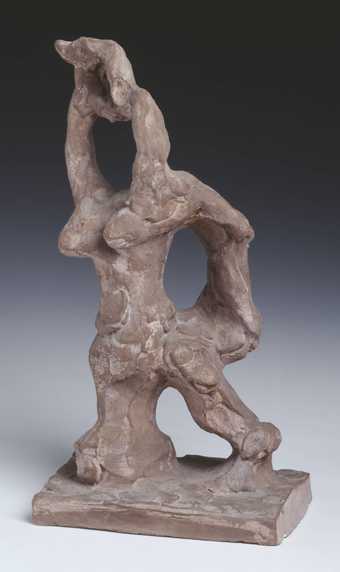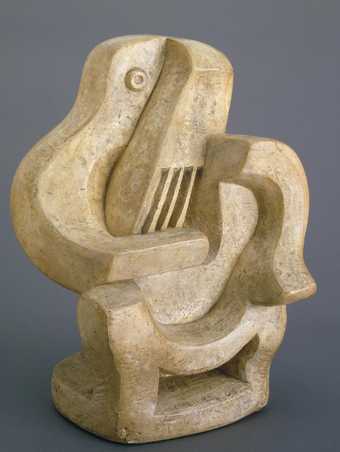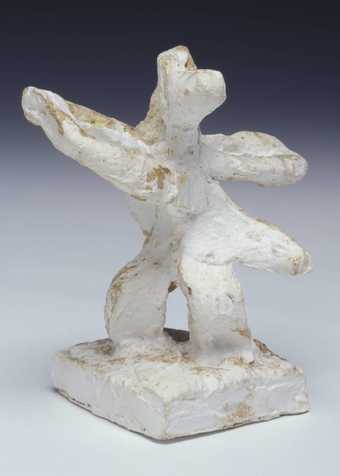
Not on display
- Artist
- Jacques Lipchitz 1891–1973
- Medium
- Limestone
- Dimensions
- Object: 980 × 280 × 180 mm
- Collection
- Tate
- Acquisition
- Purchased with assistance from the Friends of the Tate Gallery, Mrs Jack Steinberg and the Rayne Foundation 1982
- Reference
- T03397
Display caption
Lipchitz described works such as this one as 'abstract architectural sculptures'. He wrote that during this period he was 'building up and composing the idea of a human figure from abstract sculptural elements of line, plane and volume'. This indicates that, in spite of its abstraction, the work was based on the upper part of a human figure, seated at a table. Lipchitz would have made an original clay model of the work, which a professional stone-carver would probably copy to produce the final work.
Gallery label, August 2004
Does this text contain inaccurate information or language that you feel we should improve or change? We would like to hear from you.
Catalogue entry
T03397 Sculpture 1915–16
Limestone 38 1/2 × 11 × 7 1/8 (980 × 280 × 180)
Inscribed ‘J Lipchitz/16’ on base and ‘#137’ in red paint under base
Purchased from Marlborough Fine Art (London) Ltd. (Grant-in-Aid) with the assistance of the Friends of the Tate Gallery, Mrs T. Steinberg and the Rayne Foundation 1982
Prov: Estate of the artist
Exh: ? Galerie Léonce Rosenberg, Galerie de l'Effort Moderne, Paris, 1920 (probably); ? Jacques Lipchitz à la Renaissance, La Renaissance, Paris, June 1930 (16. Sculpture (pierre) 1916) (perhaps); ? Les Maîtres de l'Art Indépendant 1895–1937, Petit Palais, Paris, June–October 1937 (3. Figure (1916) Pierre) (perhaps); ? Jacques Lipchitz, Galerie Maeght, Paris, 1946 (9. Sculpture (mi-corps) Pierre 1916) (perhaps); The Essential Cubism 1907–1920, Tate Gallery, April–July 1983 (211, as 1915)
Lit: Robert Goldwater, Lipchitz, 1958, n.p. (as ‘Standing Half Figure (1915)’); Douglas Cooper, The Cubist Epoch, 1971, p.250; Lipchitz 1972, p.32; Otterlo 1977, n.p. (under 1915, as ‘Standing Figure’); Stott 1975, pp.19, 234, 272 fig.2 (bronze), 257 (22 as ‘Half-Standing Figure, 1915, bronze, 28"h)
Repr: Maurice Raynal, Lipchitz, 1920, n.p.; Roger Vitrac, Jacques Lipchitz, 1929 (27, as ‘Sculpture (pierre) 1916’)
The first cubist stone carvings by Jacques Lipchitz were made in 1916. No more than a few were carved by Lipchitz himself, although he always supervised them, and all were made from original models in clay. In the winter of 1916 he made a contract, his first, with the dealer Léonce Rosenberg, and this enabled him to employ a stone carver as an assistant. Some of the carvings were made after models of the previous year, and the style of all these sculptures is a development of that of the wooden constructions of 1915. The date cut into this carving has been read as ‘15’, but although it is not absolutely clear it is more likely to be ‘16’. It is not known when Lipchitz made this inscription, which is not on the stone in an early photograph from the Fonds Léonce Rosenberg (Caisse Nationale des Monuments Historiques et des sites, Paris), and it may refer only to the making of the stone, and not the model from which it was copied.
In his autobiography Lipchitz makes clear that these ‘abstract architectural sculptures’ needed ‘the architectural mass of stone’ (Lipchitz, op.cit., p.33), and that he had always intended them to be carved. The Tate Gallery's ‘sculpture’ is not reproduced in this book, but as it is the only such piece with a circular part as the base it is probably that described on p.34:
The next several pieces, from 1915 and 1916, illustrate what I mean. The first of these is a half-standing figure which rises from a circular base that is like the top of a table at which he is sitting. This and the others that followed it were made in clay, then in stone, and later in bronze. All of these, in the construction of interlocking planes, are developments from the earlier demountable figures. In them I was definitely building up and composing the idea of a human figure from abstract sculptural elements of line, plane, and volume; of mass contrasted with void completely realized in three dimensions.
This group of carvings are the most abstract of Lipchitz's sculptures, and in early reproductions are titled merely ‘sculpture’, yet all are of the figure. In the conversations of 1968–70 recorded by Deborah Stott he described the parts of the body in two of these sculptures, and in the passage quoted above he describes the Tate Gallery's sculpture as a figure seated behind a table. The alternative title for this of ‘Half Standing Figure’ was first published in an exhibition catalogue of 1975 (Jacques Lipchitz, Otto Gerson Gallery, New York, March 1957, '45. Half-Standing Figure. Bronze, 1916. 39"H’. It is not reproduced, but no other sculpture of this date is this size) and is probably a translation of the French ‘sculpture (mi-corps)’, used, for instance, by the Galerie Maeght in 1946. This sculpture is one of his most abstract within this group, and the only one to incorporate a cone, a shape associated with wooden or paper constructions.
It is not certain that this carving was included in the exhibitions in Paris listed above, as the titles are not explicit. The first record of it is in the book by Maurice Raynal of 1920, and since this was published at the time of Léonce Rosenberg's exhibition it is likely that it was included in it. The photographs in this book, although not titled, are stated to be in chronological order from 1915 to 1919 inclusive, and the reproduction of this carving is the second of twenty (the first is made of wood).
The plaster of this sculpture belongs to the Kröller-Müller Museum (Otterlo 1977, n.p., repr. as ‘Standing Figure (1915)’). There are several drawings by Lipchitz related to this and the similar carvings of 1916. The tallest part of the sculpture was at one time broken off, and was repaired under the direction of Lipchitz by George Koras in New York.
[For T03397 and T03479 to T03534 the foundry inscriptions, and reproductions of casts in other materials in the books listed below, are recorded. Abbreviations used:
Arnason 1969 H.H. Arnason, Jacques Lipchitz: Sketches in Bronze, 1969
Lipchitz 1972 Jacques Lipchitz, My Life in Sculpture, 1972
Stott 1975 Deborah A. Stott, Jacques Lipchitz and Cubism, 1975 (reprinted 1978)
Otterlo 1977 A.M. Hammacher, Lipchitz in Otterlo, Rijksmuseum Kröller-Müller, Otterlo, 1977
Centre Pompidou 1978 Nicole Barbier, Lipchitz: oeuvres de Jacques Lipchitz (1891–1973) dans les collections du Musée National d'Art Moderne, Paris, 1978
Arizona 1982 Jacques Lipchitz. Sketches and Models in the collection of Arizona Museum of Art, Tucson, Arizona. Introduction and catalogue by Peter Bermingham, 1982]
Published in:
The Tate Gallery 1982-84: Illustrated Catalogue of Acquisitions, London 1986
Explore
- abstraction(8,615)
-
- from recognisable sources(3,634)
-
- figure(2,270)
- non-representational(6,161)
-
- geometric(3,072)
- furnishings(3,081)
-
- table(754)
- actions: postures and motions(9,111)
-
- sitting(3,347)
- figure(6,809)
You might like
-
Jacques Lipchitz Head
1915, later cast -
Jacques Lipchitz Bather III
1917–8, cast 1960s -
Jacques Lipchitz Seated Man with Clarinet I
1920 -
Jacques Lipchitz Sculpture
1916 -
Jacques Lipchitz David and Goliath, on a Column
1933 -
Jacques Lipchitz Seated Bather
1916–7 -
Jacques Lipchitz Figure
1915, cast 1964 -
Jacques Lipchitz Meditation
1931, cast 1960s -
Jacques Lipchitz Woman with Hair
1932, cast 1960s -
Jacques Lipchitz First Study for ‘Toward a New World’
1934, cast 1965 -
Jacques Lipchitz Jacob and the Angel
1931, cast 1960s -
Jacques Lipchitz Reclining Woman
1921 -
Jacques Lipchitz Woman Leaning on a Column
1929, cast 1960s -
Jacques Lipchitz Guitar Player in Armchair
1922 -
Jacques Lipchitz Dancer
1929, cast 1960s

